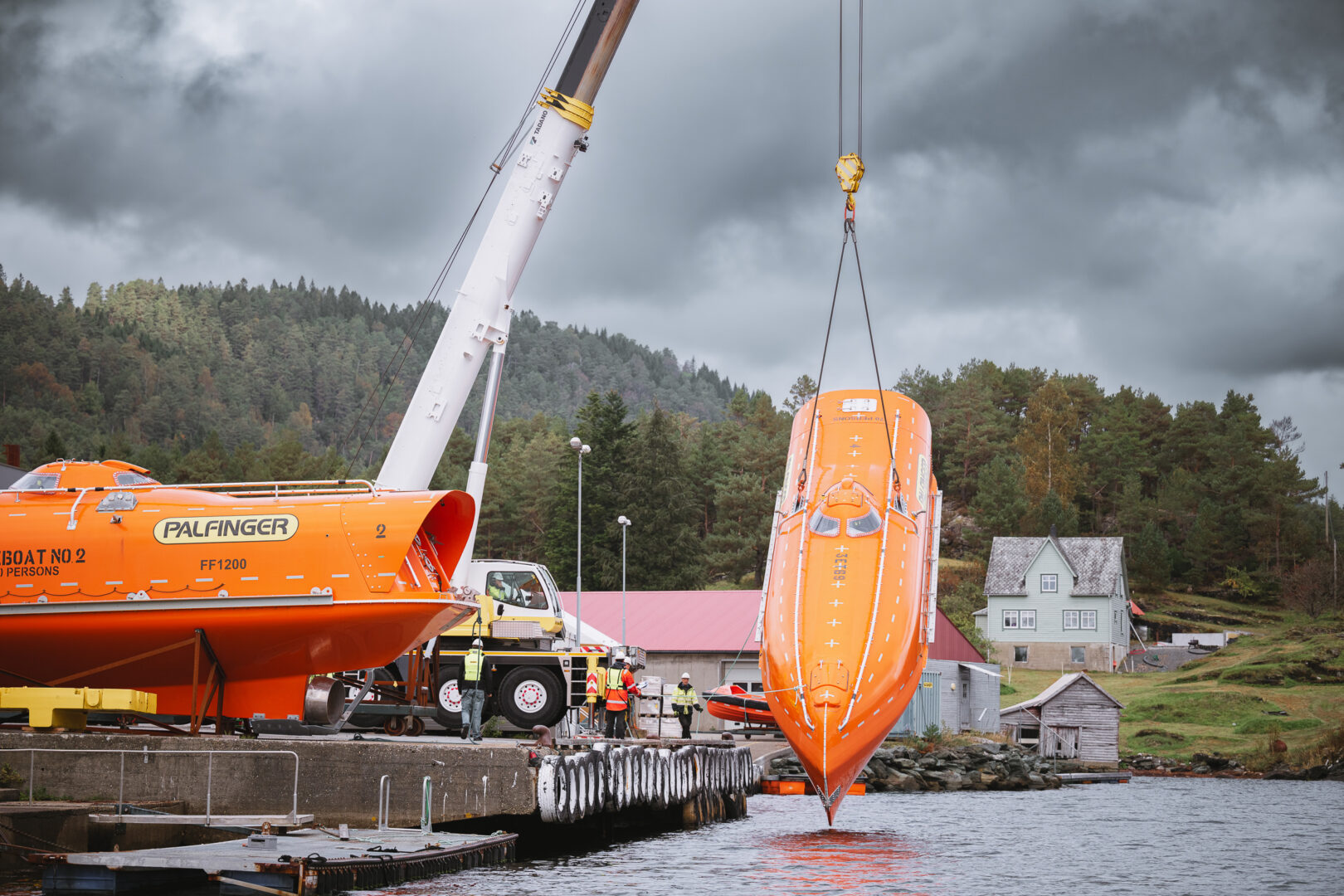Last Updated on February 6, 2025 by PALFINGER
Free-fall lifeboats are certainly among the most spectacular products within the PALFINGER MARINE portfolio. We took the Factory Acceptance Test (FAT) of four state-of-the-art FF1200 lifeboats at a partner’s testing facility in Norway, as an opportunity to sit down with Oddgeir Maelen, Global Sales Manager Offshore & Oil and Gas. We were eager to learn more about these lifeboats that can drop into heavy seas from truly dizzying heights. Let’s find out what they’re all about.
As the leading developer of free-fall lifeboats for offshore installations and merchant vessels, PALFINGER MARINE helps to ensure safe and fast evacuation in case of emergency. The FF1200 free-fall lifeboat is our flagship product and there is no better person to share insights about it than Oddgeir.
MEETING THE HIGHEST STANDARDS
The FF1200, which offers superior safety and comfort for up to 70 passengers, can drop into the sea from the dizzying height of 46 meters. For context, that’s about as high as an average 15-floor building. To ensure the safety of the evacuees, each seat is equipped with a comfortable 5-point seat belt. The high-power 280 hp engine guarantees that the lifeboat can navigate swiftly, even in the most adverse conditions.
While these specs are impressive, Oddgeir is most proud of the boat’s certification standard:
The FF1200 complies with the strictest available freefall lifeboat standard, known as DNV-ST-E406.
This standard is based on 50 years of knowledge of harsh offshore environments, incorporating insights from lifeboat manufacturers, oil companies, offshore workers, and classification societies. Our FF1200 excels in all four focus points of the standard: strength, headway, acceleration forces, and occupant comfort.”
When asked about the most challenging aspect of developing a free-fall lifeboat, Oddgeir is quick to point out that the obvious answer, the strength of the boat itself, is not the only issue: “The trick is to ensure that the lifeboat enters the water at a sufficiently steep angle to reduce impact forces while simultaneously gaining substantial positive headway. This is where the FF1200 sets new standards. It optimizes headway speed while minimizing the G-forces experienced by occupants.” Given the lifeboat’s sophisticated design, almost every model we deliver is identical. “However, we do need to take the respective customer’s davit interface structure into account. That can be challenging,” Oddgeir explains. “In the case of the FF1200s that just successfully passed their FAT, we will deliver them with our LA1200 SU twin davits,” he adds.
TESTING PROCEDURES

Speaking of the FAT, we were eager to learn more about the testing process. “The testing procedure involved checks of the starting system, engine instruments, gear and throttle controls, and lights. We also closely examined pressure levels in both the air system and bottles before checking safety features such as emergency steering and anti-fire sprinklers,” explains dedicated Project Manager Anne Berit Nerhus. “The FAT also included internal and external markings, communication systems, and GPS capability, as well as a speed test to verify the minimum top speed of the empty boat is 6 knots,” she adds. “As you can see, the checklist we went through in attendance of two customer representatives was quite extensive, even though it did not yet include the free-fall test itself. But, as expected, we passed all tests with flying colors,” Anne Berit says with a smile.
SAFETY FIRST
The evacuation of a vessel or offshore facility is a highly dangerous and complex procedure. Every element of an evacuation plan is geared towards saving lives – and every step matters. “Our solutions are part of the comprehensive evacuation analysis, which considers all aspects of any vessel or offshore facility. It examines key features such as emergency routes and communication systems, to name a few. Our lifeboats are, for example, particularly important in terms of maintaining communication with the command center on the rig or mothership,” Oddgeir explains. “It’s a huge responsibility, and we’re proud to shoulder it. We obviously hope that our lifeboats are never needed, but our job is to ensure that they function perfectly when the need arises,” he insists.
We hope you enjoyed this in-depth look at our flagship free-fall lifeboat. Browse through the extensive collection of photos and videos to gain more visual insights into the topic. And make sure to come back for more stories about exciting PALFINGER MARINE solutions in action.



